What is it like to be caught up in a chemical attack?

 Andy Weekes/Loughborough University
Andy Weekes/Loughborough UniversityNerve agents like novichok, sarin and VX can produce symptoms similar to a heavy cold at first, but they kill in minutes and spread fear almost as toxic as the substances themselves.
The battered white van looks like it has been abandoned – its front bumper is missing and one of the rear tyres is partially deflated. A few people mill around nearby, talking and laughing in the otherwise quiet square. They don't notice the wisp of smoke curling out from beneath the vehicle.
Within a couple of minutes, it has turned into a torrent, pouring around the doors and from an exhaust pipe protruding below the van. Those standing nearby are almost completely obscured by the white cloud and a woman lets out a small scream as a sudden shift in the wind sends the plume billowing in my direction.
As it spills around me I get the faint taste of old chewing gum. I can hear people coughing and shapes nearby drop to the ground. Some splutter and cry out for help. Others lie very still. It takes 20 minutes before hazy blue flashing lights emerge around the corner, indicating help is on its way. Firefighters climb into cumbersome protection suits with full breathing apparatus. They move from victim to victim, checking who can be saved and who is beyond help.
Fortunately for me and the others in the small southern Finnish town of Mikkeli, this is just a rehearsal – preparation for an exercise the following day that will simulate a chemical attack. The scenario – a terrorist cell has released a toxic nerve agent into a market square amid the lunchtime bustle – is designed to test pioneering new technology that could transform how emergency services respond to chemical releases.
But what do we know about the reality of events during a chemical attack? How do people respond, and can anything really be done to prevent a serious loss of life?
You might also like:
In Finland, the victims were all played by volunteers who were acting, but the scenario is based on very real and horrifying events.
In 1995, the Aum Shinrikyo cult released sarin on busy trains during rush hour in five coordinated attacks that killed 13 people and injured thousands more. A year earlier, a sarin attack by the same group killed eight and left 600 people injured.
“It was the starting point for our project,” explains Paul Thomas, an analytical chemist at Loughborough University in the UK who is leading the Toxi-Triage project that is behind the exercise in Mikkeli.
 Andy Weekes/Loughborough University
Andy Weekes/Loughborough UniversityOne of the people who survived the 1995 attack was Atsushi Sakahara, a former advertising executive now living in Kyoto, Japan. He stood just yards from one of the packages of volatile liquid containing sarin. “At first I didn’t think much of it,” he recalls. “My eyes felt dry, a bit like I had strained them. But I had an important presentation to give to a client that morning so I went to the office.” It would turn out to be an event that would affect him for the rest of his life.
Sakahara’s day had started as normal, snoozing his radio alarm for a few minutes before getting up and making the short uphill walk to the train station where he bought a newspaper and boarded the Hibiya Line train at Roppongi station to start his daily 15-minute commute towards Tsukiji station.
“When the train arrived I was reading an article in the newspaper about the sarin attack in Matsumoto about nine months earlier,” recalls Sakahara. “The third door of the first train car was less crowded so I got on there. On the left side there was a plastic bag. I nearly sat down beside it, but changed my mind.”
His instinct was correct. The plastic bags, which had been wrapped in newspaper, contained a solution that consisted of 30% sarin. Two stops before Sakahara boarded the train, a member of Aum Shinrikyo set the package on the floor and punctured it with the sharpened tip of an umbrella, allowing the contents to evaporate into the carriage.
 Getty Images
Getty Images“There was a guy sitting next to the bag who didn’t look very well – he was kind of slumped and sweating,” says Sakahara. “I just felt like I shouldn’t be there. Maybe I should have yelled, to tell everyone else to get out too, but I didn’t. I wish I had.”
Instead Sakahara moved to the front of the second carriage, along with a couple of other passengers who slammed the dividing door behind them. When he looked back, Sakahara says he saw a pregnant woman in the carriage he had just left. It is a memory that has stuck with him as he watched the terrible effects of the sarin take effect.
“I was told she was OK, but I don’t know what happened to her,” he said. As the train set off again, the man he had seen earlier keeled over. “Someone said he had fainted. When we arrived at the next stop, Kamiyachō station, he was carried out and the station staff rushed over.”
Sarin can take effect within seconds of being inhaled and symptoms can appear within a minute of exposure. It can be lethal in around 5-10 minutes. As a vapour, however, it is heavier than air and so will have taken some time to fill the carriage. Passengers were also reported to have opened windows on the train as they began to feel unwell. It was a step that could have saved many lives in the carriage – only one person lost their life on the train Sakahara was on.
In the minutes that followed, the front carriage of the train was evacuated and an announcement said there had been an explosion at Tsukiji station. In truth there was no explosion – another train targeted in the attack had pulled onto the platform and passengers had staggered out and collapsed. The quickly unfolding events led to confusion.
“Tsukiji was my destination,” says Sakahara. “So, I decided to get off the train and left the station.” He took a cab to his gym, tried to do a short work-out but then decided to have a shower before his meeting with clients.
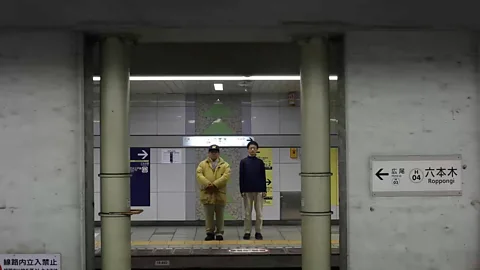 Good People Inc
Good People Inc“I was starting to feel horrible but the shower helped me,” he says. Without realising it, Sakahara had followed three of the key steps recommended by the US Department of Homeland Security in the event of a chemical attack – getting into clean air, removing his clothes and washing with soap and water.
“When I went back outside, though, it was like I was looking out through very strong dark glasses,” he adds. Darkened vision is a typical symptom of sarin exposure along with eye pain, pupil constriction, nausea and nose bleeds. It was only when Sakahara met a colleague in the office lift, who commented on his bloodshot eyes, did he realise what might be happening.
“He told me I should go to a hospital,” says Sakahara. “When I got to the hospital there were so many victims there already. I had a headache by then and my eyes were painful. I was covered in a sticky sweat. A doctor came to see me and I asked him what it might be. He said ‘no idea’.”
It would be several hours before the Japanese authorities were able to determine that sarin was responsible. While lethal doses of nerve agents can act within seconds to minutes, the immediate signs of mild or fleeting exposure can also be frustratingly nondescript – irritated eyes, dizziness, headaches, excessive mucus and difficulty breathing. The could be mistaken for a heavy cold if they didn't come on so quickly.
The packages that contained the poison had been picked up and disposed of by station staff, who would too become victims of the attack.
How nerve agents kill
Sarin and other nerve agents like VX and Novichok are a group of chemicals known as organophosphates – which also include many pesticides.
Sarin is 25-50 times more toxic than cyanide, while VX is twice as toxic again and Novichok agents are five to eight times more lethal than that.
They kill by disabling an enzyme called acetylcholinesterase, which is responsible for breaking down acetylcholine, a molecule that sends messages between nerve cells. Without this vital “off-switch” acetylcholine builds up in the nerve synapses – the point where two ends of a neuron meet – overstimulating the victim’s muscles and secretory glands.
This constant switched-on state causes the eyes to water, sweating, nausea, fluid in the respiratory system and uncontrollable, jerky movements. Without rapid medical intervention, victims will collapse and become comatose, suffocating to death due to the spasming muscles in their respiratory system.
Another problem following the chemical attack was panic. “In Tokyo, the hospitals were overwhelmed by thousands of people seeking medical help and reassurance after the sarin attacks,” says Thomas. “The vast majority – about 80% of those – did not need hospital care. You can imagine what impact that has on a busy hospital when you have hundreds of people turning up like that. If your grandmother happens to have a stroke on that day, she is not going to get the care she needs. The lethality of that is too awful to bear. As many people or more will be harmed as a result of that congestion as would be hurt by the event.”
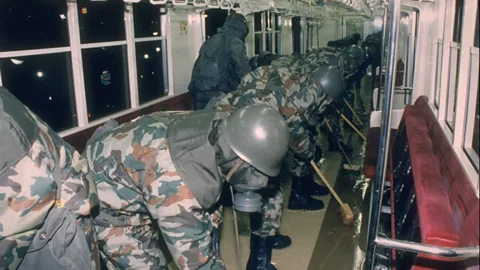 Getty Images
Getty ImagesThis is where Thomas believes new technology could help – by allowing rapid diagnosis following future attacks. For example, researchers at German electronics firm Gesellschaft für Analytische Sensorsysteme, or Gas for short, have developed a breath analyser that can detect low levels of biochemicals known as metabolites, which are produced by the human body as it reacts to harmful chemicals. In Mikkeli the smoke has been laced with peppermint and the volunteers were given peppermint oil capsules as a substitute for sarin that produces metabolites the instruments can detect.
By simply blowing into a plastic tube that has a syringe plunger attached, the breath of hundreds of potential victims can be analysed quickly. “It can give us an answer in about 40 seconds,” says Emma Brodrick, a systems application manager at Gas who helped develop the BreathSpec device.
Back in Mikkeli, Finland, I watch another type of sensor technology supporting the emergency services during the rehearsal. There is a faint buzzing as through the smoke – coloured white so it can be seen in this exercise – a small drone emerges. On board it is carrying highly sensitive, miniaturised instruments that sample the gas and wirelessly beam back the results to emergency crews.
“The drone lets us get samples from close to the source without putting personnel at risk,” explains George Pallis, an engineer and managing director of T4i, the company behind the technology. “It can also take samples over a wide area very quickly so we can get an idea of spread too.”
The Toxi-Triage consortium have also been developing technology that can pick up the signatures of poisonous chemicals from greater distances. Using specialised cameras that pick-up visible, ultraviolet and infrared light – known as hyperspectral imaging – it is possible to detect characteristic patterns that betray the presence of a chemical agent.
While at a much earlier stage than the drone-based technology, these hyperspectral detection systems could be used in handheld devices or mounted on aircraft that can fly overhead. Looking further ahead, the team behind it hope such technology could also be mounted on satellites with high-resolution optics, allowing authorities to monitor for the use of chemical weapons in war zones.
In places like Syria, where reports of chemical weapons use have relied upon information provided by local teams on the ground and subsequent testing of victims often days after the alleged attack, it could transform the ability to pinpoint attacks and find those responsible.
 Getty Images
Getty Images“It is informed vigilance that is key to effective prevention,” says Tatyana Novossiolova, a research fellow who studies the threats posed by chemical and biological weapons at the Center for the Study of Democracy in Sofia, Bulgaria. The responsibility for this vigilance is not just something for the authorities, but each and every one of us if we want to combat the threat posed by chemical weapons, she argues.
“This entails knowing whom to turn to, should one find themselves in a risky situation or emergency, such as being familiar with the relevant responsible authorities or services and knowing how best to reach them.”
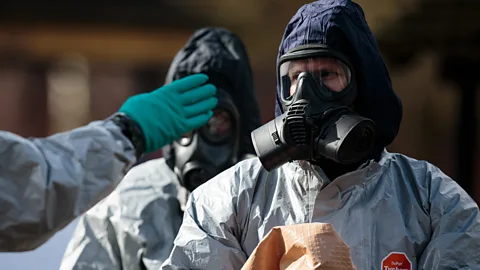 Getty Images
Getty ImagesFor those authorities and emergency services responding to a chemical attack or an accidental release of harmful chemicals, knowing what substance is involved is crucial.
In 2018, a mysterious chemical haze swept on shore from English Channel, causing widespread panic as members of the public reported breathing difficulties and eye problems. It took months of investigation before the most likely source was identified as a ship venting gas out in the channel, but emergency teams struggled to know how to respond at the time.
“If they had our kit, they would have known, as soon as they arrived on scene, exactly what they were dealing with,” says Thomas. Understanding exactly what agent has been released is a crucial first step in any response, he explains.
The precautions and response can vary depending on the chemical responsible, while those exposed have to be treated in different ways. For example, with nerve agents and some pesticide poisonings it is common to give patients the drug atropine. But atropine should not be given to those exposed to the incapacitating agent 3-Quinuclidinyl benzilate, better known as BZ, as it can worsen its effects.
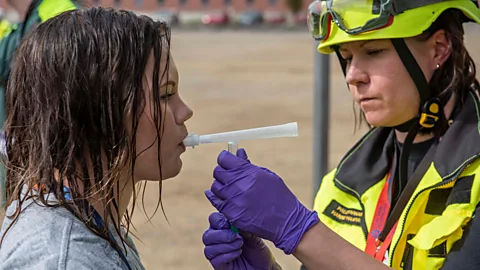 Andy Weekes/Loughborough University
Andy Weekes/Loughborough UniversitySome nerve agents also have specific antidotes that if given quick enough can save lives.
Researchers like Janice Chambers and her team at Mississippi State University are also trying to develop better antidotes to nerve agents that can help to reduce the effects they can have on the brain.
“Our objective is not just survival, but survival with minimal or no damage to brain function,” says Chambers. But she warns it could still take many years before their new drugs – known as oximes – get approval from regulatory authorities.
Decontamination can also drastically reduce the lethality of chemical weapons as the longer a substance is left on skin and clothes the more of it can enter the bloodstream. Victims have their clothes stripped from their bodies before being vigorously washed and scrubbed in hastily erected decontamination tents by emergency personnel wearing protective gear. Tests have shown that decontaminating within 15 minutes of exposure even to highly lethal nerve agents like VX can dramatically improve a victim's chances.
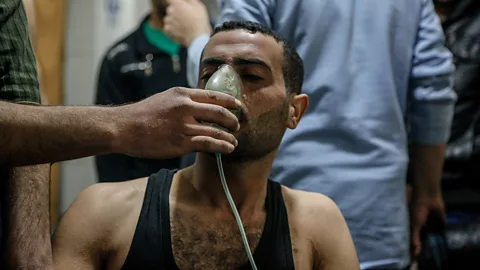 Getty Images
Getty ImagesThe volunteers in Mikkeli are surprisingly stoic throughout this doubtless embarrassing and rather abrasive part of the exercise they are taking part in. As they reach the end of the decontamination tent, a hand-held device that looks a little like an electric sander is run over their skin. This clever bit of kit – known as a Gas Detector Array X – can identify the presence of harmful chemicals on skin, clothing and other surfaces. It is a bit like a Geiger counter, but for chemical agents rather than radiation.
Each “victim” is also wearing a coloured wrist band, snapped on by the firefighters as they examined them. Inside is a wireless “smart” chip rather like those in a contactless payment card that when scanned with a mobile phone can reveal who they are, where they were in the incident, changes in their condition and what treatment they have received. Breath, blood and urine samples taken from them can be similarly tagged. Together it helps the emergency services keep track of victims as they are then taken to hospital.
A few are given black wristbands, an indication that they have “died”.
The exercise in Mikkeli is over in a few hours and the battered van that was the source of the gas is towed away. But in a real incident it could be days or even weeks before an area subjected to a chemical attack is safe for people to use again. Some chemical weapons, such as sulfur mustard and VX, can persist in soil for more than a month. Large areas of land between Lille and Verdun in France remain “no-go” red zones where the public, farming and forestry are banned due to the millions of tonnes of toxic gases unleashed during World War One. Cleaning up the tonnes of unexploded munitions that are unearthed here each year is a time-consuming and difficult task.
But the US’s Defense Advanced Research Project Agency has been developing a portable “soil scrubber” to destroy chemical weapons by burning them and passing the gas through beds of carefully selected soil to turn the gases into harmless salts.
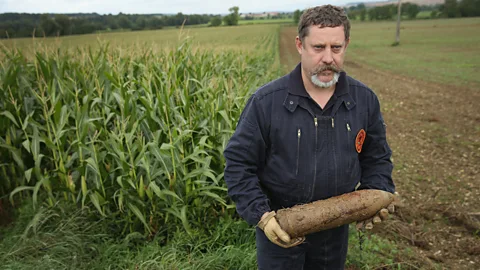 Getty Images
Getty ImagesPerhaps a longer lasting legacy is the impact that chemical weapons and accidents can have on their victims. Survivors of the Bhopal accident in India were found to be suffering from a wide range of serious long-term health problems more than 30 years after they were exposed to the toxic gas. Their children also bear the scars of the incident – their limbs twisted and brains damaged.
There are few studies on the long-term effects of chemical weapons, but reports from doctors and survivors of attacks suggest they too leave a legacy of disease and congenital birth defects. One recent study on Kurdish survivors of chemical attacks in Iraq in 1988 showed they suffered from deteriorating physical and psychological health, including breathing problems, sleep disorders, eyesight issues and anxiety. Many lived in constant fear of another attack.
Research on survivors from the 1995 sarin attacks in Tokyo also reveal heart problems, muscle defects, and breathing difficulties. The survivors also show memory impairments and carry deep psychological scars.
Atsushi Sakahara is 52 years old now and still wrestling with the effects of his experience. Physically he says he coughs a lot; his eyes struggle to adjust to changes to light. He also suffers from severe fatigue and occasional paralysis in his arms and legs when stressed. Psychologically he struggles too.
“It’s hard, I feel insecure now when I go out,” he says. His regret at not shouting to warn others on the train about his concerns also still burns bright. “I have a lot of guilt about it.”
But despite what he has endured, Sakahara has also shown it is possible to overcome adversity. He now works as a film director and won a Palm d’Or at Canne for a short film called Bean Cake in 2001. He is currently working on a documentary about the cult behind the attack he survived, Aum Shinrikyo.
“I want to help others to understand what happened,” he says. “It can never happen again.”
This article is part of a new BBC Future column called Worst Case Scenario, which looks at the extremes of the human experience and the remarkable resilience people display in the face of adversity.
--
If you liked this story, sign up for the weekly bbc.com features newsletter, called “If You Only Read 6 Things This Week”. A handpicked selection of stories from BBC Future, Culture, Capital, and Travel, delivered to your inbox every Friday.
